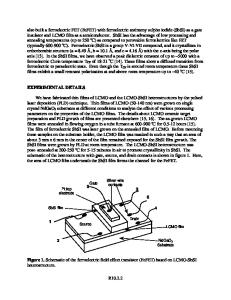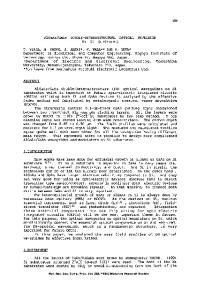Device Performance of Laser Annealed Double Heterostructure GaAlAs Materials
- PDF / 455,447 Bytes
- 4 Pages / 415.8 x 637.2 pts Page_size
- 41 Downloads / 266 Views
Inc.
Gibbons, Hess, and Sigmon, eds.
Laser andElectron-Beam Solid Interactions and ':aterials Processing
295
DEVICE PERFORMANCE OF LASER ANNEALED DOUBLE HETEROSTRUCTURE
,M.J. BRETT, J.A. ROSTWOROWSKI AND R.R. PARSONS, Dept. of Physics, University of British Columbia, A.J. SPRINGTHORPE, C.M. LOOK, AND J.C. Bell-Northern Research, Ottawa, Canada
GaAlAs MATERIALS1
Vancouver,
Canada
DYMENT,
ABSTRACT We have laser annealed double heterostructure GaAlAs material with homogeneous ruby laser pulses such that maximum laser light absorption occurs in the active layer. With laser anneal intensities sufficient to melt the active layer, the radiative efficiency of the double heterostructures was reduced by a factor of two. Performance of electroluminescent devices fabricated from annealed material was much worse than performance of devices fabricated from unannealed material.
INTRODUCTION In recent work [1] we have shown that the quantum efficiency of the band edge emission of GaAs increased by several orders of magnitude after laser annealing with a Q-switched ruby laser. This work was extended to studies of laser annealed double heterostructure (DH) GaAlAs materials, reported at the previous conference [2]. Unfortunately, the radiative efficiency of the DH material was drastically reduced after laser annealing. Here we report a photoluminescence study and device performance data of electroluminescent lasers fabricated from laser annealed DH material. In contrast with our previous work on double heterostructures, the laser anneal was performed using a beam homogeniser. The radiative efficiency of the DH was only reduced by a factor of two after an anneal using the homogeniser. EXPERIMENT Heterostructures consisting of n-Ga. 6 Al. 4 As (I pm thick), p-Ga. 9 3 A. 0 7 As (0.2 Am) and p-Ga. 6 Ai. 4 As (1 pm) were grown on n-GaAs substrates by liquid phase epitaxy [3,4]. Previous calculations have shown [2] the suitability of ruby laser light for annealing the active Ga.9 3 AI. 0 7 As layer; 23% of the incident light is absorbed in the active layer whereas less than 1% is absorbed in the confining layers. A calculation of the temperature profile [5] following a 20 ns ruby laser pulse showed that the heat generated does not have time to reach the surface of the exposed confining layer and thus an increase in absorption due to bandgap shrinkage could be neglected. It was estimated that the threshold 2 to melt the active layer was 0.15 J cm- . 2 Heterostructure wafers, each about 1 cm in area, were annealed with 20 ns Q-switched ruby laser pulses of various intensities above and below the melting threshold. A beam homogeniser, similar to that described by Cullis et al. (6],
iSupported in part by the NSERC of Canada,
grant #67-7804.
296 provided an intensity distribution uniform to within 5%, estimated from studies of laser annealed polysilicon films. It was hoped that a homogeneous anneal would provide optimal regrowth of the active layer, the quality of which is of primary importance for device operation. Each wafer wa







